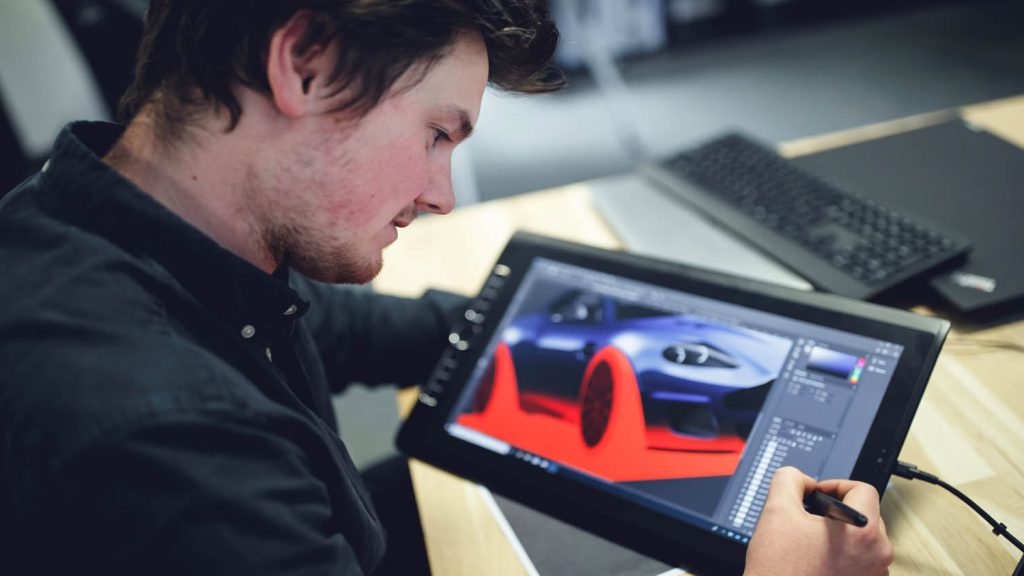We spoke to young professionals working at some of the most prestigious automotive companies based in the UK to find out more about what it means to be in their position, how they got there and what they believe the future holds
Car design and engineering is a notoriously competitive field in which to gain a foothold. Whether new entrants come from a design university, an apprentice degree programme or some other route, they are expected to be highly qualified, have a clear vision for the future and possess a strong creative drive.
As jobs in the industry change, so do the requirements and the skill sets that applicants need to demonstrate. Car designers and engineers are today tasked not only with developing new models and technologies, but also ensuring that the industry keeps pace with – or even leads – the massive societal shifts we are seeing.
The next few decades will be crucial in terms of the impact that technology development will have on the sector. We regularly hear all kinds of wild speculation about the kinds of cars we will all want to own in two or three decades’ time. But let’s take a look instead at who will be driving us there.
Taylor Lawrence, Product development higher apprentice
Ford Motor Company
What part did education play in your career path? Was it all about which course at university you got on to, or did you undertake an apprenticeship or a different route?
Ever since I was young, I have always been interested in Formula 1, so as I grew up, I always envisaged a career being in and around cars. In which way, I did not know at the time, but I always knew that I would end up in this area. This passion, in addition to maths/ science being subjects I did well at in school, it somewhat felt a natural decision to pursue a career in automotive engineering and what better way to do that than with an apprenticeship, especially one with a degree at Ford?
I always remember that when I joined sixth form, we were given a university/ apprenticeship assembly, describing the options.
The careers advisor started describing degree apprenticeships, and I remember turning to my friend and saying, “This is the best of both worlds. I would really like to do that after I leave.” And that’s where I ended up. If I had never known what they were, I would never have looked into degree apprenticeships.
Being in such a competitive industry, what do you think makes you stand out? How important is it for young designers to find their niche?
Finding a niche is relatively important. Becoming an expert in a certain subject area helps you stand out and become the directly responsible individual known not just in your immediate team but also the wider company.
On the flip side though, I would suggest that a ‘stand out’ is actually being open to all areas of the business, an eagerness to understand the widest aspect of a process as possible, helping to open your eyes to problems or concepts you may not have found but also compassion and consideration that may not be had with a niche focus.
How do you think the automotive industry needs to be reshaped in the next decade, if at all, and what role will designers and engineers from your generation play in this transformation?
I think the automotive industry is undergoing its reshaping now, and it can be summed up like this. [Ford CEO] Jim Farley described how the mobile phone started off just as a means to phone one another. Now it is a camera, laptop, notepad, PlayStation and so compact it fits in our pocket. Not to say that cars will go that small, but he described that this is the car’s time to undergo a mobile phone-style transformation.
To be a part of that, growing up in the digital world is a benefit not just to us, but also the industry.
Jessica Sandwith, Mechanical engineering degree apprentice
Ford Motor Company
What part did education play in your career path? Was it all about which course at university you got on to, or did you undertake an apprenticeship or a different route?
As my education progressed, it was imperative to finetune and focus on subjects that would propel me towards my engineering ambitions. At the start of sixth form, I was adamant to go straight to university, get my degree, and then try to land a career.
The pandemic consequently changed the teaching and therefore my learning, which negatively affected my grades. I began looking into alternative options, with the mindset that my grades wouldn’t get me into the university that I desired. One of the options was an engineering degree apprenticeship; the more research I did, the more attractive this became. I could have a full-time, salaried job whilst getting a degree paid for by the company? With my previous lack of work experience, apprenticeships were increasingly appealing. However, the requirements from the companies providing degree apprenticeships, in terms of grades, were even more selective than those from universities. Furthermore, I found myself striving to obtain better grades with the sole purpose to get a degree apprenticeship. I applied to numerous companies and went through the hiring processes. Fortunately, I was successful in a few of my applications. After a lot of thought and comparisons, I chose the Mechanical Engineering Degree Apprenticeship with Ford Motor Company.
Apprenticeships are somewhat looked down upon and not really mentioned in the academic environment. There is a shortage of skilled workers in my generation and a lot of it is to do with educational priorities and stereotypes. The traditional university route is narrowminded and is sometimes deemed to be the ‘only way’ to become successful.
Being such a technical industry, how much room is left for creativity, especially in entry-level positions?
Creativity comes from the individual, but must be harnessed. Working in such a technically involved industry comes with lots of bureaucracy. Although the restrictions can be overwhelming at times, they are implemented for a good reason. A compromise is necessary between new ideas and guidelines which, in turn, calls for even more divergent thinking. The industry is ever-evolving, so there is an abundance of creativity needed. Sharing my ideas and thinking of new solutions, even if they are faulty, provides a different perspective for others. Collaborating creatively will eventually bring about the greatest success.
Charlotte Jones, Colour, materials and finishing (CMF) designer
Callum
What made you follow this career path and how did you land your first job in the industry?
I’ve always enjoyed working in creative roles, whether that be studio work in a screen-printing company or creating my own children’s clothing design business. Fashion and textiles have been my primary areas of experience, but Callum’s diverse range of projects presented an opportunity to work together on the Callum Lounge Chair. While automotive may not be my background, I’m now working on the company’s projects in this sector, which has been a great learning curve and one I’m thoroughly enjoying.
Being such a technical industry, how much room is left for creativity, especially in entry-level positions?
I’m very lucky in my role, as there’s a huge opportunity to be creative. I can play with patterns, colour and, to a point, materials as well. The automotive industry is moving towards cleaner, greener ways to use materials, resulting in lots of development and new opportunities.
Is there something that you have realised since you started working in the industry that you wish you had known when you were starting out?
Adaptability is hugely important. Things move fast, especially in smaller businesses, so you need to be able to respond to changes quickly. But I find this really exciting and provides a lot of opportunities to grow and build your skill set.
There is an opportunity here for designers to reinvigorate car design as our visions of what a ‘car’ is evolves
How do you think the automotive industry needs to be reshaped in the next decade, if at all, and what role will designers and engineers from your generation play in this transformation?
Sustainability and creating cleaner vehicles are a priority for the future, of course. But this mustn’t come at the cost of great design.
There is an opportunity here for designers to reinvigorate car design as our visions of what a ‘car’ is evolves.
Aleck Jones, Creative lead
Callum
Being in such a competitive industry, what do you think makes you stand out? How important is it for young designers to find their niche?
At Callum, I have a young team of very talented designers and I see it more and more that the skills new graduates come out of education with are exceptional. With all the free powerful tools – Blender, Unreal, etcetera – at their disposal, the standard of work that students can create is amazing. But increasingly this is becoming the norm, so finding a niche has become more important than ever. Ultimately, creativity is what we look for: being able to find interesting solutions to problems, thinking outside the box, or just being bold with design work in general. I’m always keen to see work that continually pushes new ideas.
Being such a technical industry, how much room is left for creativity, especially in entry-level positions?
There are enormous opportunities. Creativity is our fuel. We always start our projects by going a little wild to find that initial theme. We have a process at Callum that we call ‘order out of chaos’. The chaos is that initial creative sprint that, ultimately, we apply a little order to, which turns that spark of an idea into something tangible, with all the relevant feasibility.
In terms of creativity in entry-level positions, I always look to younger members of the team to challenge the ideas that Ian Callum, myself and the others put forward. We’ve been in the industry for a while, especially Ian, so too often, it’s easy to jump straight to the solution and there might be an overlooked opportunity along the way.
What are the benefits of starting out in a small car company as opposed to a major marque?
Having experienced both, working at major marques and small design studios each have their own benefits. At Callum, we are an intentionally small team; this gives us great freedom in terms of the speed we work and the projects we take on. Because of our size, we need ideas from everyone, whether that be for a hypercar or a piece of luggage, and this presents opportunities for all team members. For example, we had an automotive project that needed some focus, so we set our design intern on this, as he’s gaining experience across the business. The theme he put forward was brilliant, so we let him take the lead on the full project, seeing it through all the stages of design. As is the goal with all our design work, it’s now in the process of being built. It’s these opportunities and exposure to the full process that can get diluted once you’re part of a much larger team.
Is there something that you have realised since you started working in the industry that you wish you had known when you were starting out?
Confidence is key. And things don’t need to be perfect all the time. I have often found myself working late into the night, perfecting a sketch or a render, only for it to be shelved. One of the things I tell the team here is to focus on getting ideas down quickly and cohesively. Sometimes a simple sketch is more than enough to sell an idea; it’s easy to get caught up in the process and try to perfect things too soon.
Karl Dujardin, Designer
Toyota Europe Design Development
What made you follow this career path, and how did you land your first job in the industry?
Firstly, I really didn’t expect to join the automotive industry. In my studies, I was strongly attracted to creativity in general, in areas such as fine arts, architecture and design. Then I decided to study applied art. I spent three years studying product design, with the aim of learning fundamental design aspects: object semantics, form and function. While I was doing this, I joined the Delsey luggage company. It was an amazing experience, where I learned a lot about the design process, merging both colour, material, usability, shape and technical constraints. After this experience, I was determined to become a designer. I then joined Dior and experienced two different departments: visual merchandising and packaging design. Here, I gained experience in the luxury field with its strong values. I trained myself to consider the tiniest details while I created the products. While I was working on packaging, we had to consider how to make the fragrance more attractive, while taking the Christian Dior design legacy into account. It was a really rewarding period where I started to build my own personality as a designer.
Is there something that you have realised since you started working in the industry that you wish you had known when you were starting out?
I have no regrets concerning my job choice; I feel lucky every day to be able to earn a salary doing what I like and am good at. Nevertheless, as it is one of the most competitive design fields, we obviously face many difficulties.
In a way, it forces you to reassess yourself quite often. But those challenges are great, as they force us to continuously escape from our comfort zone. Also, as we are creative people inside colossal industries, we are naturally exposed to many frustrations.
We often have to manage our creative emotions and frustrations, yet that’s the role of industrial and automotive designers. That’s why it is essential to always remain positive.
How do you think the automotive industry needs to be reshaped in the next decade, if at all, and what role will designers and engineers from your generation play in this transformation?
The automotive industry is facing big changes, such as the energy question (from fuel to electric), the autonomous driving experiment, the primordial needs of sustainable design (mainly through industry processes), and the mobility experience.
We are probably entering a new era that gives rise to many new human needs. As creatives, we welcome those changes, and designers have the capacity to deep dive into the new way of designing, taking different approaches.
Our scope of work has been widening, we can co-create new ideas including business models with product planning teams. Design thinking allows us to change social issues into new solutions.
Our design goal is to rebuild the mobility experience, taking those new challenges into account from a different perspective.






